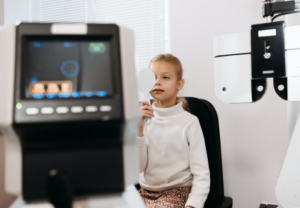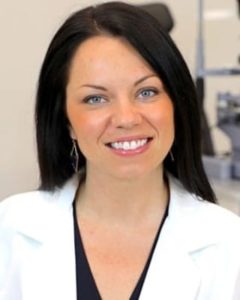Sponsored Content
June 15, 2021
By Sheila Morrison, OD, MS, FSLS
It is imperative to articulate to the parent that myopia management is long term and that you’re in it together with the child.
 Over the past year and a half, we’ve seen podcasts and online content about myopia management explode in the optometric space. I’ve been grateful for the opportunity to learn from diverse key opinion leaders across North America. Many discussions are centered on how and what to “recommend” in regards to the most optimal myopia management plan because no two patients are alike. Recently, at our practice, I was faced with a family that felt confused about the importance of proceeding with treatments that I had “recommended.” Somewhere along the way, our consistency with using the word “prescribe” has actually been inconsistent. To quote Peter Shaw-McMinn, OD, “prescribe” translates to “expertise.”1 As eye care providers (ECPs), we’ve invested the time going through optometry school, continuing education, and the clinical experiences in our careers to “prescribe” from a place of expertise and authority. Using the word “recommend” may diminish the value, almost sounding like the treatment is optional.
Over the past year and a half, we’ve seen podcasts and online content about myopia management explode in the optometric space. I’ve been grateful for the opportunity to learn from diverse key opinion leaders across North America. Many discussions are centered on how and what to “recommend” in regards to the most optimal myopia management plan because no two patients are alike. Recently, at our practice, I was faced with a family that felt confused about the importance of proceeding with treatments that I had “recommended.” Somewhere along the way, our consistency with using the word “prescribe” has actually been inconsistent. To quote Peter Shaw-McMinn, OD, “prescribe” translates to “expertise.”1 As eye care providers (ECPs), we’ve invested the time going through optometry school, continuing education, and the clinical experiences in our careers to “prescribe” from a place of expertise and authority. Using the word “recommend” may diminish the value, almost sounding like the treatment is optional.
Modern myopia management involves consideration of age, refractive error, patient and parent history, and lifestyle. A myopia consultation must take all of these components into account and be tailored to each patient (and family) in order to effectively communicate complex science in a simple fashion. Whether these families are new or already established with your practice, the parents or caregivers of children with myopia must trust ECPs to do what’s in the best interest of their child.
Utilizing the Available Research and Resources
In light of the many myopia management tools in our toolbox, our clinical decision making and prescribing patterns must be informed by evidence-based literature. In a 2019 report on ethical considerations by the International Myopia Institute (IMI), ECPs are advised to consider topics related to product efficacy, safety, appropriate referrals, and on-label versus off-label prescribing.2 Industry support of academic and clinical research has propelled our profession forward in producing a high quality scientific evidence base. Off-label prescribing is common in many forms of medicine and should always be done with informed consent to ensure that the off-label nature is well understood.2 When appropriate, the use of on-label therapies as first choice per the IMI is a powerful method to gain credibility with parents and caregivers of children with myopia and other health professionals.
In clinical practice, the use of CooperVision’s MiSight 1 day soft contact lenses is our only on-label prescribing option to slow the progression of myopia in children who are -0.75D to -4.00D and have ≤ 0.75D of cylinder. These are the candidates for MiSight on label when between the ages of 8 to 12 at the initiation of treatment.* Due to ethical considerations clinicians face when prescribing any medical device for children, I anticipate that over time we will see more commonly used devices and products gain on-label approvals to specifically slow myopia.
Taking the Time to Educate Patients and Parents
Once the decision has been made to “prescribe” a specific treatment, it is important to provide accurate information about other treatment options, but avoid spending so much time that it potentially overwhelms and confuses the parent. There are options, but they are not all equal.
It is imperative to articulate to the parent that myopia management is long term and that you’re in it together with the child. When applicable, remember to emphasize short-term benefits of contact lenses, such as self-esteem (ACHIEVE study, 2006), which is positively linked to higher confidence levels and improved academic and athletic performance.3 Our goals for myopia management are the same as any other ocular disease: provide a lifetime of healthy vision.
Communication between ECPs and parents is enhanced by providing resources such as digital brochures or treatment summary pages, which may be independently created within a practice or institution. Industry programs such as Brilliant Futures can also provide this support for practitioners, and it is smart for ECPs to explore and utilize these types of programs to support their business plans, staff training, and patient care.
Trust Your Knowledge and Experience
When family physicians prescribe a medication, we trust that they’ve considered risk versus reward and cost versus benefit ratios. Similarly, we come armed with the expertise and knowledge to predict a range of outcomes expected based on a wide breadth of peer-reviewed studies and publications over many years; we apply this knowledge to how the child in the chair may or may not be similar to the children in the studies.
At our practice, Mission Eye Care, we see children with myopia in our Myopia Control Academy, elevating and conveying how serious we are about helping children over time. We continue to advance our approach as more evidence gets published so that children with myopia can have the brightest futures possible. Our mission is to ensure that the decisions we make today most effectively impact children in minimizing myopic progression to promote the best quality of life and eye health for the rest of their lives. Occasionally a family may decline or delay enrollment into the program, but with time dedicated to delivering education and providing the “why” we do what we do, enrollment is the norm.
Best practices in “prescribing” for myopia management are continually evolving with the times and with our vision science community. I encourage ECPs to refer to credible publications and studies, especially randomized clinical trials, and “prescribe” confidently. By doing so, parents will recognize that myopia management is not only appropriate for their child, but it is actually necessary.

Sheila Morrison, OD, MS, FSLS, specializes in myopia control and corneal disease at Mission Eye Care in Calgary, Alberta, Canada. She previously served on the faculty at the University of Houston College of Optometry as a clinical instructor for the myopia control clinic and as chief of the Contact Lens and Cornea clinic at the University Eye Institute.
References
- https://www.optometricmanagement.com/issues/2015/november-2015/do-you-8220;recommend-8221;-or-8220;prescribe
- Jones L, Drobe B, González-Méijome JM, Gray L, Kratzer T, Newman S, Nichols JJ, Ohlendorf A, Ramdass S, Santodomingo-Rubido J, Schmid KL, Tan D, Tan KO, Vera-Diaz FA, Wong YL, Gifford KL, Resnikoff S. IMI – Industry Guidelines and Ethical Considerations for Myopia Control Report. Invest Ophthalmol Vis Sci. 2019 Feb 28;60(3):M161-M183. doi: 10.1167/iovs.18-25963. PMID: 30817831.
- Walline J, Jones LA, Chitkara M, Coffey B, Jackson JM, Manny RE, Rah MJ, Prinstein MJ, Zadnik K. The Adolescent and Child Health Initiative to Encourage Vision Empowerment (ACHIEVE) Study Design and Baseline Data. Optom. Vis. Sci. 2006 Jan;83(1):37-45. doi: 10.1097/01.opx.0000195566.94572.eb.
*Indications for Use: MiSight® (omafilcon A) daily wear single use Soft Contact Lenses are indicated for the correction of myopic ametropia and for slowing the progression of myopia in children with non-diseased eyes, who at the initiation of treatment are 8-12 years of age and have a refraction of -0.75 to -4.00 diopters (spherical equivalent) with ≤ 0.75 diopters of astigmatism. The lens is to be discarded after each removal.













